Learn
More About Orchids
Greenhood Orchids with Dr. Graeme Lorimer
Greenhood orchids (genus Pterostylis) are fascinating plants which have evolved a complex structure for attracting insects in order to reproduce.
Anglesea Orchid Experiences with Margaret MacDonald
Margaret writes about her passion for the Anglesea orchids.
ANGLESEA ORCHID EXPERIENCES
By Margaret MacDonald
[article first published in the Australasian Native Orchid Society Geelong Group Bulletin, March 2019]
My introduction to the world of orchids began in 1989 when my sister Kath Morgan and I found some small pink flowers growing on the ridge between Fairhaven and Moggs Creek. We asked lots of the locals what they might be, but were not able to get an answer. However one day when looking through a book called ‘What Flower is That’? we found an answer, as there was a picture of our flower and its name Hare Orchid Leptoceras menziesii. 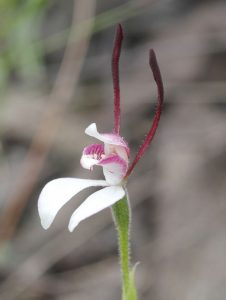 So that was enough to set us out to find if other orchids were found in the area. And here I am now thirty years later and have discovered that there are over 110 species of orchids in the Anglesea district. Unfortunately the journey I had planned into the world of orchids with my sister was cut short with Kathie’s death in 1994. However the passion kindled by those little Hare Orchids has stayed with me over the years as I continually explore the Anglesea area greeting each species as it comes into flower each year. I have enjoyed so many experiences with ANOS members and in particular with Everett Foster who shared with me in so many field visits and in the documenting of our orchids in Orchids of the Anglesea District.
So that was enough to set us out to find if other orchids were found in the area. And here I am now thirty years later and have discovered that there are over 110 species of orchids in the Anglesea district. Unfortunately the journey I had planned into the world of orchids with my sister was cut short with Kathie’s death in 1994. However the passion kindled by those little Hare Orchids has stayed with me over the years as I continually explore the Anglesea area greeting each species as it comes into flower each year. I have enjoyed so many experiences with ANOS members and in particular with Everett Foster who shared with me in so many field visits and in the documenting of our orchids in Orchids of the Anglesea District.
Every one of these orchids has a story to tell but I am just choosing a very small number to share with you in this bulletin and my apologies to the others!
In November 1992, Kathie and I shared the exciting rediscovery of Thelymitra x merraniae Merran’s Sun Orchid at Moggs Creek. 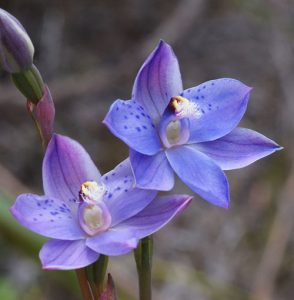 First discovered in the Moggs Creek area in 1929, but not mentioned for a very long period of time, Kathie and I delved into the literature documented at the time of its discovery, and after weeks of exploring bush tracks found what we thought was this elusive orchid. We picked one flower from the flowering stem and carefully took our precious find to Melbourne where Geoff Carr identified that it was indeed Thelymitra merranae as it was named by W.H.Nicholls at that time. Publicity was great and many visitors came to Moggs Creek to see the orchid. We were thrilled that Geelong ANOS chose it as the logo for their group.
First discovered in the Moggs Creek area in 1929, but not mentioned for a very long period of time, Kathie and I delved into the literature documented at the time of its discovery, and after weeks of exploring bush tracks found what we thought was this elusive orchid. We picked one flower from the flowering stem and carefully took our precious find to Melbourne where Geoff Carr identified that it was indeed Thelymitra merranae as it was named by W.H.Nicholls at that time. Publicity was great and many visitors came to Moggs Creek to see the orchid. We were thrilled that Geelong ANOS chose it as the logo for their group.
Six years later in September 1998 I was walking in the O’Donohue Heathlands with a friend visiting from Melbourne when we stumbled upon a magnificent sight of over 200 quite large white finger orchids in amongst an area of Grasstrees and Eucalypts. I contacted Everett and we relayed our find to David Jones in Canberra who visited the area. It was just before we published our first edition of the Orchid Book and David told us to call it Caladenia aff. catenata. We were disappointed when a few weeks later David ‘s paper came out naming a new species of orchid endemic to the Anglesea district –Caladenia maritima Angahook Caladenia.  It would have been nice for us to have had the privilege of including the name of our orchid in the first edition of our book!
It would have been nice for us to have had the privilege of including the name of our orchid in the first edition of our book!
Jump forward 10 years and I was taking my dog Canya for a walk along a bush track at the back of Moggs Creek. I had been admiring the Pterostylis melagramma Tall Greenhoods that were growing in good numbers on the side of the track mainly near the base of the eucalypts. Suddenly Canya wandered over to the other side of the track and when I followed him I saw this tall greenhood growing there that looked very different. It was a different shade of green; it didn’t have a dark brown stripe on the labellum, rather a green one; the shape of the hood was more rounded and the lateral sepals were wider. It was indeed a new discovery for our district Pterostylis chlorogramma Green-striped Greenhood.  Everett and I were very excited – I’m not too sure about Canya. I think we found about 30 of these orchids when Everett came down to see them at Moggs Creek. Since 2008 we have found this orchid growing in the Bald Hills area not in large numbers but certainly some fine specimens.
Everett and I were very excited – I’m not too sure about Canya. I think we found about 30 of these orchids when Everett came down to see them at Moggs Creek. Since 2008 we have found this orchid growing in the Bald Hills area not in large numbers but certainly some fine specimens.
Just 12 months later in September 2009 I had been asked to lead an orchid field trip for a group of Australian orchid enthusiasts. We had certainly had a good day but when I looked at my watch there was still about 30 minutes before the bus was due to pick them up. We had seen a few Caladenia deformis Bluebeards 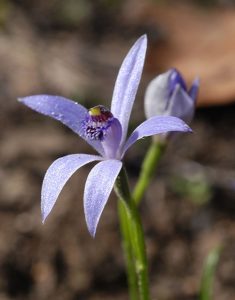 growing in the area where we had finished up and there were as usual for Anglesea lots of Caladenia major Waxlips. Facetiously I said “Well there’s $50 for the person who can find me the hybrid between the two species x Caladenia tutelata.
growing in the area where we had finished up and there were as usual for Anglesea lots of Caladenia major Waxlips. Facetiously I said “Well there’s $50 for the person who can find me the hybrid between the two species x Caladenia tutelata.  Without drawing breath I stated “Well you needn’t bother!” There just where we were standing was this special orchid. I had never sighted it before, but there was no doubting what it was, so I saved my $50! We found one other one close by. It was just such an exciting find and so great to be able to share with these orchid enthusiasts. I think the bus was delayed waiting for keen photographers to get their photos but nobody minded.
Without drawing breath I stated “Well you needn’t bother!” There just where we were standing was this special orchid. I had never sighted it before, but there was no doubting what it was, so I saved my $50! We found one other one close by. It was just such an exciting find and so great to be able to share with these orchid enthusiasts. I think the bus was delayed waiting for keen photographers to get their photos but nobody minded.
It was interesting that this orchid also appeared in about 7 other sites within Victoria that spring.
I always say you can’t have favorites in the autumn world but unless you have got down on your knees to look carefully at Corybas Helmet Orchids you are missing a real orchid experience. Two Corybas experiences jump into my mind:
September 2010 I had sent Mike Duncan and Dean Rouse out to find Corybas fordhamii Swamp Helmet Orchid. I knew where it should have been found – I had seen the odd flower and a few tiny leaves with my friend Mary White. However the swampy site had been thrashed by 4WD and trailbikes who had ridden through the area as the main track was impassable. Mike and Dean found the area but were not successful in finding the orchid. So they then proceeded to follow the Anglesea River further upstream and were rewarded by finding a good colony of these delightful orchids. It was the day of the ANGAIR Wildflower Show so Peter Kiernan and I got up very early the next morning so we wouldn’t miss out on them and we were delighted to find the colony. There had been a lightning strike the previous year and the Swamp Helmets were easily seen. They still grow there but with the increased vegetation are more difficult to find.
The second Corybas experience was at the end of my own street in Moggs Creek when again dog walking in June 2014 I noticed a large number of leaves coming up in an area that had been cleared within the Great Otway National Park. I was unsure what they were, but it wasn’t long after that that tiny reddish flowers started to appear and it was obvious that we had a large colony of Corybas unguiculatus.the Small Helmet Orchid. 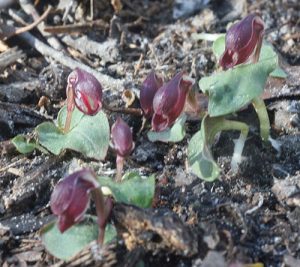 This is not a common orchid in the Anglesea district so this was a significant find. The area has continued to produce flowers each year. They are so very tiny but just so perfect in every way.
This is not a common orchid in the Anglesea district so this was a significant find. The area has continued to produce flowers each year. They are so very tiny but just so perfect in every way.
To finish up let’s return to the Anglesea river valley where the Swamp Helmet Orchid had been found in 2010. Taking some friends in to see them that year – I’m pretty sure it was Colin and Mischa who discovered a very small number of Burnettia cuneata Lizard Orchids  growing in the swampy area. That was an unbelievable experience for me. I know that they flowered in large numbers after the 1983 fires but of course that was before my introduction to orchids. But Everett had organised a plane trip to King Island just to see this species. As I felt I would never see them in Anglesea I joined the trip, and apart from experiencing my first blood sucking leeches I was pleased to see the Lizard Orchid. You can imagine how excited I was to see it in my own domain the Anglesea river valley.
growing in the swampy area. That was an unbelievable experience for me. I know that they flowered in large numbers after the 1983 fires but of course that was before my introduction to orchids. But Everett had organised a plane trip to King Island just to see this species. As I felt I would never see them in Anglesea I joined the trip, and apart from experiencing my first blood sucking leeches I was pleased to see the Lizard Orchid. You can imagine how excited I was to see it in my own domain the Anglesea river valley.
Yes as I said earlier every orchid in the Anglesea District has a story for me. I would love to share them all with you. The orchids I have seen are all photographed and described in Orchids of the Anglesea District the 3rd edition of which was completed the year before Everett died. He was so keen to see it published in 2009 and I feel he had a premonition that his life was coming to an end. I think we willed the first Rosy Hyacinth Orchid Dipodium roseum to open so that we could get a photograph of Everett and me in the Edna Bowman reserve. I really like and treasure this photo as I do all the memories I have of sharing orchid experiences with Everett. 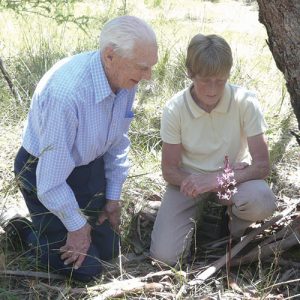
I have certainly enjoyed my Anglesea orchid experiences over the past 30 years and I’m still looking forward to what tomorrow might bring!
Tribute to Margie Morgan
ANGAIR would like to acknowledge the contribution of Margie Morgan, Margaret MacDonald’s dearly loved niece who sadly died earlier this year.
As an ANGAIR member, but especially through her publishing business Inverted Logic, Margie has made very significant contributions to ANGAIR. Margaret has always relied on Margie for her publishing expertise (given at much reduced rates) in the publication of the books and brochures she has authored eg Orchids of the Anglesea District, Flowers of Anglesea and Aireys Inlet (book and brochure), ANGAIR A Natural History Study, the several ANGAIR Achievements brochures and the first Surf Coast Shire Weed booklet.
Most recently, Margie did the design and layout for ANGAIR: the first 50 years. Her work on that project was invaluable!
For many years, Margie has been of enormous assistance to Margaret at the Annual Wildflower Weekend – preparing and ‘manning’ the Orchid display and helping to reconnoitre and lead the orchid excursions.
Margie and Margaret have been very close friends and her loss is a huge blow to Margaret and to ANGAIR.

